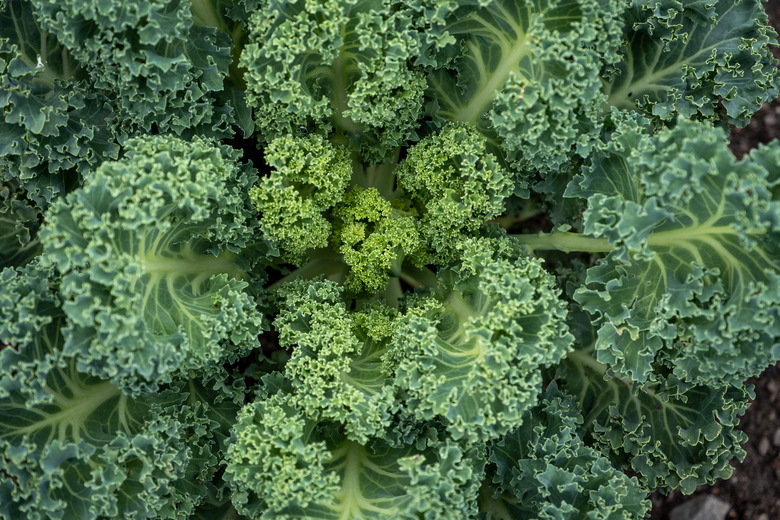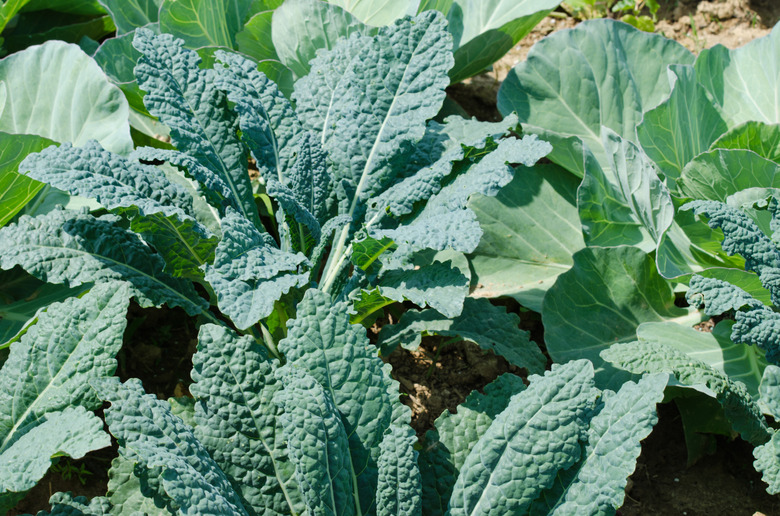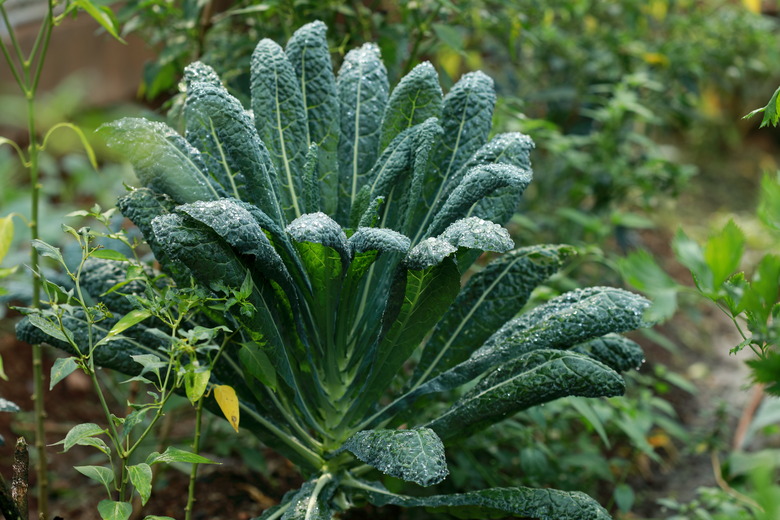How To Grow Kale
We may receive a commission on purchases made from links.
A cousin to broccoli and cabbage, kale (Brassica oleracea [Acephala Group]) is so easy to grow that it could be a fun planting project for the smallest, burgeoning gardeners. Somewhat unique in the plant world, kale can be planted regularly during the growing season to produce a steady supply of food. Kale tolerates a bit of cool weather, and many varieties even taste a bit sweeter after a cold snap. It's also a good choice for container gardens that are limited to patio or balcony space provided that the area gets a decent amount of sunlight.
Best Uses for Kale
Best Uses for Kale
Kale is an excellent food for eating raw in salads and smoothies, or it can be baked into crispy kale chips as a replacement for other crunchy, salty snacks. It's also a nice addition to your favorite stir-fry dish or even a homemade pizza. Kale is rich in nutrients such as vitamins A, C and K as well as fiber, calcium and iron.
Ornamental kale serves as an added pop of color for your yard or garden in the fall and even into winter. In vivid colors such as purple, pink and red, the frilly leaves on an ornamental kale plant look as beautiful as flowers and are able to withstand much colder temperatures than the average flower.
While ornamental kale is edible, it tends to be more bitter than the varieties grown specifically for food. Plant ornamental kale near the front edge of a flower bed as a decorative replacement for summer blooms that have long since faded. It also looks nice as the focal point in the center of a container, planted along with your favorite annual autumn flowers.
How to Grow Kale
How to Grow Kale
How to Start Kale From Seed
How to Start Kale From Seed
Kale is exceptionally easy to grow from seed, and you'll start to see results in as few as five days. For kale that's ready to harvest in summer, sow these tiny seeds 2 inches apart and 1/4 to 1/2 inch deep in a sunny location in spring as soon as the soil is soft enough to work. Kale seeds also do well when started indoors about six weeks before the last frost of spring; this helps them mature before intense summer heat. For a harvest in fall and winter, sow seeds in mid to late summer.
Kale isn't incredibly picky about when it's planted. In fact, you can plant it continually through most of the year to have fresh, tender kale leaves ready to harvest for months on end. Sow seeds directly into the soil every one to three weeks once the daytime temperatures average 65 to 75 degrees Fahrenheit for a steady supply of young kale leaves. This is the best option for getting tasty kale leaves you plan to eat raw during the warm months of the year, as tender, young leaves taste better than older, coarser leaves maturing through the hottest parts of summer.
Starting Kale From a Seedling
Starting Kale From a Seedling
Although kale is an easy plant to start from a seed, seedlings are also available at garden centers to transplant directly into the ground. Alternatively, you can also sow seeds in containers to transplant in your garden at a later date.
In a warm climate or to grow kale into the winter, plant seedlings in late summer or about two months before the first expected frost. Mix in some compost with the soil for added nutrients if desired. Allow about 18 inches of space between kale plants or between kale and other plants, as kale plants widen on their tops as they mature. In hot climates, planting the kale between taller crops such as corn or tomatoes offers much-needed shade from the hot summer sun.
If you are planting kale in containers, choose pots that are about 12 inches deep and wide with drainage holes. After heavy rain, make sure the pot's drainage holes aren't blocked, which could cause the pot to retain too much water. If necessary, carefully dump out excess water. Otherwise, water kale planted in containers, in raised beds or in the ground about 1 inch per week or a little more during hot, dry periods.
In What Zone Does Kale Grow Best?
In What Zone Does Kale Grow Best?
Kale grows in virtually any zone as an annual but does best when it gets to experience cool weather. A cold snap with a light frost can make kale taste even sweeter. Kale even grows in zones 8 through 11, which face some of the hottest weather in the United States. The key for these zones is to plant kale in late summer so much of the growing season is in cooler weather. In areas with somewhat moderate summers and winters, kale can be planted in spring or late summer.
When Should You Plant Kale?
When Should You Plant Kale?
While kale could technically be planted outdoors at any time other than in winter when temperatures may stay below freezing for a while, hot summer weather is best avoided. Young transplants may not be able to tolerate full sun in the heat of summer. If they do take hold, their growth may be stunted.
A light mulch such as straw can help keep the soil temperature more favorable for growing if the weather forecast predicts unseasonably hot or cold temperatures for days on end.
Soil, Sunlight and Water Recommendations for Kale
Soil, Sunlight and Water Recommendations for Kale
Kale prefers soil with a pH range of 6.5 to 6.8 for optimal growing health. Full sun or at least six hours of sunlight per day is best for kale, although in the hottest summer weather, a little shade is good for this plant. Water kale about an inch of water per week or about 1 gallon per square foot per week total. Mulch helps keep the soil moist between waterings.
Weeding is also important, even in containers and raised-bed gardens, as the weeds compete for moisture and nutrients in the soil, especially as the kale establishes itself.
How to Propagate Kale
How to Propagate Kale
Although propagating kale from a stem cutting isn't as effective as with other plants, such as basil or ivies, it can be done. The reason most growers prefer seeds or seedlings is that propagating kale is an incredibly slow process compared to propagating many other plants. But if you'd like to do so, here's how to go about it:
- Choose a healthy outer branch from the main stem of the kale and then cut it off near where it connects to the main stem using clean pruning shears.
- Remove most of the lower leaves from the cutting and then place it in water or in potting medium.
- Keep the cutting in a well-lit space but out of direct sun. In water, you'll be able to watch the root-growing process, whereas in soil, it's harder to tell when the roots have developed. In general, it takes at least three weeks to notice any root development.
- If grown in water, transplant the cutting into potting medium once its roots take up a bit of space in the jar. If planted in a pot with soil, the cutting can be left in the pot if the pot is large enough or can be transplanted in a garden once the danger of frost has passed in spring or well before frost in late summer or early fall.
How to Harvest Kale
How to Harvest Kale
Kale leaves are ready to harvest when they're about the size of the palm of your hand. Young, tender leaves are ideal if you are eating the kale raw, such as in a salad or in place of a wrap. Otherwise, harvest leaves from the outer, lower portion of the plant by carefully breaking off their stems or by using clean garden shears.
Always leave the top cluster of about four leaves intact, as this is the area most responsible for growth. Allow some kale leaves to stay intact until after the first frost, as the flavor sweetens and improves quite a bit. During the heat of summer, old leaves that have been growing for months may have a coarser texture once they thicken and the edges curl depending on the variety. These are still edible, but they may not be quite as palatable as young leaves or leaves maturing around the time of a frost. Kale stems are also edible and can be left on the leaves for a stir fry or other cooked dishes.
Once you've picked the kale, rinse each leaf under running water to remove any dirt or debris. Pat the leaves with paper towels to remove most of the moisture and then store them wrapped in a slightly damp paper towel inside of a plastic produce storage bag that has holes in it. A regular plastic food-storage bag also works; just leave it open slightly. Store the bag in the fridge for a week or so if the bag contains full kale leaves. Kale is strong enough that you can also cut it in advance and store it in the bags for several days in the fridge before it wilts.
Common Pests and Other Problems for Kale
Common Pests and Other Problems for Kale
Cabbage worms and cabbage aphids are two of the most common pests affecting kale plants. Cabbage worms are the green larvae of the small cabbage white butterfly; these creatures eat holes in the kale leaves. Although the holes are unsightly, they generally don't affect the health of the plant, but in mass quantities, worms create quite a few holes in the kale leaves. Fecal matter from the worms could also be on the kale leaves, so be sure to wash the leaves before eating them.
If you find worms on the kale, remove them manually. Placing row covers over the plants helps prevent the cabbage moths from laying eggs on the kale. It also helps to keep birds and other curious wildlife from eating the plants.
The fuzzy, greenish-gray cabbage aphid sucks juices out of the kale, which could lead to fungal issues on the plant. These insects can also be removed manually.
Common Diseases for Kale
Common Diseases for Kale
Besides the fungal issues potentially caused by aphid damage, kale is also prone to black rot and leaf spot. Black rot happens most frequently during prolonged hot, rainy weather. It causes plant leaves to develop yellow lesions that eventually turn brown and black. This could cause the plant leaves to die. Xanthomonas leaf spot is another bacterial problem that causes spots on the leaves, usually in the form of brown circles.
Other leaf spot problems are similar in appearance, all resulting in blighted kale leaves. Once entire plants are affected, the bacterium or the fungus causing the problem could remain in the soil, so it's best not to plant similar crops in the same area for several years. Spray fungicides are available as a last-resort treatment for severe fungal plant issues.


